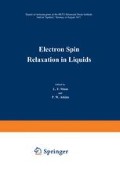Abstract
Spin relaxation is one example of a general class of relaxation processes where the subsystem of interest is weakly coupled to a large bath or reservoir. The essential feature of such processes is the wide separation in the characteristic time scales of relaxation of the subsystem and the bath. If the coupling of the spin subsystem to the bath is ‘weak’ one finds that the spins relax on a ‘slow’ time scale relative to the lattice motion of the bath. One consequence of this separation of time scales is that the spin subsystem density matrix, to a certain degree of approximation, may be described by a master equation. To lowest order this equation of motion is only valid on the ‘slow’ time scale and is known as the Redfield equation. Another consequence is the existence of simple linear laws for the relaxation in the magnetization or other dynamical variables of interest. For many spin systems, in lowest order, the equations of motion for the macroscopic magnetization have the form of the Bloch equations which are also only valid on the slow spin time scale. A third consequence of the separation of time scales is that the relaxation times which appear in the Bloch or Redfield equations may be expressed as Fourier transforms of time correlation functions. To lowest order the time dependence of the correlation functions involves only the fast lattice motion.
Access this chapter
Tax calculation will be finalised at checkout
Purchases are for personal use only
Preview
Unable to display preview. Download preview PDF.
References
The derivation of the Redfield-Langevin equation has been accomplished in collaboration with Dr. John Albers. In preparing these lectures I have profited from discussions with Miss Barbara Yoon.
See, for example, A.G. Refield in Advances in Magnetic Resonance Academic Press, Inc., New York and London,(1965), Vol.1, p.1 and references cited therein.
M. Bixon and R. Zwanzig, Phys. Rev. 187, 267 (1969).
J. Albers, J.M. Deutch and I. Oppenheim, J. Chem. Phys. 55,2613 (1971).
P.N. Argyres and P.L. Kelley, Phys. Rev. 134A, 98 (1964).
See also R.I. Cukier, Ph.D. Thesis, Princeton University (1969), unpublished.
The type of projection operator employed by Mori in his generalized theory of Brownian motion [Prog. Theor. Phys. 33, 423 (1965)] is suitable for obtaining equations of motion for macroscopic variables not distribution functions. For magnetic relaxation the Mori projection operator is pm(...) = (..., s) • (s,s)-1 • S where (A,B) is an appropriately defined equilibrium average.
The statement that a is an eigenmatrix of ??? with zero eigenvalue is universally made. Explicit verification of this fact in a complete quantum mechanical treatment is quite difficult. Any difference which might exist in special cases between ??? and the correct form of the equilibrium eigenmatrix of R would, under normal conditions, not be experimentally observable.
I.V. Aleksandrov, The Theory of Nuclear Magnetic Resonance (Academic Press, Inc., New York and London , 1966), pp. 65–74.
J.M. Deutch and Irwin Oppenheim in Advances in Magnetic Resonance, ed. J.S. Waugh (Academic Press, Inc., New York and London, 1968), Vol. 3, p. 43.
J. Freed, J. Chem. Phys. 49, 376 (1968). It should be noted that Freed’s development explicitly assumes that the lattice motion may be treated in a stochastic manner. In contrast, in the development presented here, the Hamiltonian is entirely mechanical.
R. Kubo in Fluctuation Relaxation and Resonance in Magnetic Systems, ed. D. Ter Haar (Oliver and Boyd, London, 1962), p. 23.
A detailed review of these various procedures may be found in the excellent review article by C.S. Johnson, Jr. in Advances in Magnetic Resonances, ed. J.S. Waugh (Academic Press, Inc., New York and London, 1965), Vol. I, p. 33.
M.C. Wang and G.E. Uhlenbeck, Rev. Mod. Phys. 17, 323 (1945).
R.I. Cukier and J.M. Deutch, J. Chem. Phys. 50, 36 (1969).
A. Abragam, The Principles of Nuclear Magnetism (Oxford University Press, London, 1961), Chapter 8, p. 276 et seq.
The analysis presented in reference 14 includes only the Δ = 0 terms. Here we extend the MTS treatment to include the A ≠ 0 contributions.
Author information
Authors and Affiliations
Editor information
Editors and Affiliations
Rights and permissions
Copyright information
© 1972 Plenum Press, New York
About this chapter
Cite this chapter
Deutch, J.M. (1972). Two Approaches to the Theory of Spin Relaxation: I. The Redfield Langevin Equation; II. The Multiple Time Scale Method. In: Muus, L.T., Atkins, P.W. (eds) Electron Spin Relaxation in Liquids. Springer, Boston, MA. https://doi.org/10.1007/978-1-4615-8678-4_7
Download citation
DOI: https://doi.org/10.1007/978-1-4615-8678-4_7
Publisher Name: Springer, Boston, MA
Print ISBN: 978-1-4615-8680-7
Online ISBN: 978-1-4615-8678-4
eBook Packages: Springer Book Archive

